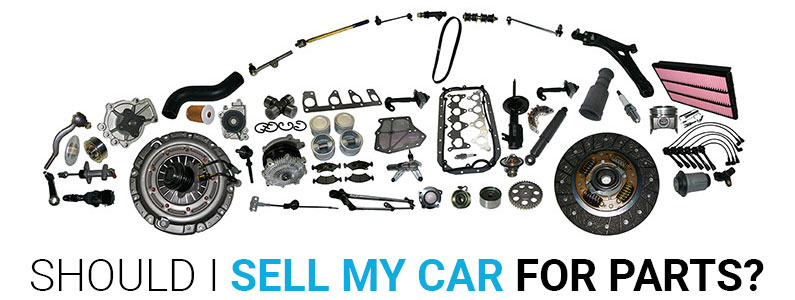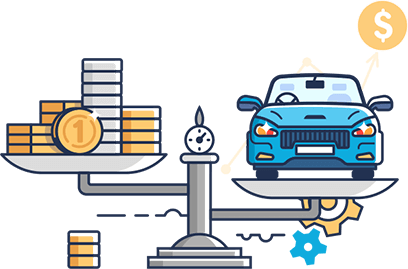How To Part Out Your Car & Get Cash
Parting out a car is one way to maximize the profits for an old, junk car. You can sell individual parts first, before selling the remaining shell of the vehicle for its weight in scrap metal.
Particular components (like your engine, catalytic converter, and transmission) can net a nice profit, while other components (like engine fluid and oil) can be recycled.
That said, dismantling your car to sell these parts requires the tools, knowledge, and effort to accomplish. Without being both a mechanic and having a specialized garage, attempting to part out your vehicle can damage the parts and decrease their value at best or, at its worst, be dangerous for you.
With only a few components of your vehicle commanding high resale value, the rest of your car is of little worth to most buyers. Once those parts are gone, the rest of your vehicle may be sitting in your driveway indefinitely.
If you’ve got a vehicle you’re trying to get rid of quickly and want to see the value of your car, then check out our instant value calculator.
To learn how to maximize the profits from parting out your car, continue reading below. We’ll be covering:
What it means to part out a car.
Which parts are in highest demand.
Which option is better: Parting out or selling wholesale.
What Does It Mean To Part Out A Car?
Parting is a simple concept wherein you (or a qualified mechanic) take out individual pieces of your vehicle and put them up for sale. The pieces can be as large as the engine or as small as the door handles.
Removing parts by yourself and with very little knowledge about the inner workings of a car is doable.
However, there are plenty of components (especially the more lucrative ones) that you shouldn’t attempt to remove without the proper expertise and/or equipment.
Let's say you have a common car like a 2007 Honda Civic with rear-end collision and you’re parting out the car.
The buyer may be willing to purchase your engine for $600, but (unless you have the time and mechanical expertise to remove it) the cost to take it out can easily amount to $500-$700 in labor.
You can let the person take the engine out themselves, but that could risk damaging the engine altogether.
On average, this is how much you can sell these parts for if they are already removed:
Engine - $500+ (Mileage dependent)
Transmission - $250+ (Mileage dependent)
Airbags - $150+ (Depending on which bag)
Seats - $80+ (Seat conditions may vary price)
Not only do you risk damaging the part (and, subsequently, lowering its value on the market), but you also risk harming yourself with heavy objects or hazardous chemicals.
If you plan to part out your car, the safest way to do it is to employ an experienced mechanic who has the knowledge, space, and equipment to do it safely.
Which Parts Are In Highest Demand?
Even old, junk cars will have big components that are in high demand and, therefore, can retain a high value. These particular parts are:
The Engine - The heart of your vehicle, your engine retains some value even if your car is old. Even when they require repair, you can sell your engine to rebuilders and, if it can pass inspection, it can be resold. A used engine can run between $1000 - $3000 on average, after labor for the removal is factored in.
The Transmission - The transmission market is a multibillion dollar one, which is no surprise due to its importance in energy transfer, regulation, and control throughout your vehicle. Metals like aluminum, steel, cast iron, and brass make your transmission liable to fetch a pretty penny when parted out.
The Catalytic Converter - A part required in every vehicle in America since 1975, the catalytic converter minimizes the amount of pollutants your vehicle produces. Catalytic converters use expensive metals like platinum, palladium, and rhodium. Commonly, they will hold 4-9 grams of these materials, making catalytic converters a lucrative bit of scrap to sell.
While these three parts are in the highest demand, there are other parts of your vehicle that can be parted out and still net you a decent profit. These parts include but are not limited to:
Rims
Airbags
Alternator
Transmission
Radiators
Doors
Is It Better To Part Out Your Car Or Sell It Whole?
Parting your car out piece by piece is a great way to maximize the value of your old car. However, it comes with its own set of drawbacks.
If you have neither the space nor the expertise for dismantling a car, then parting it out may not be in your best interest. Furthermore, having to list each part and wait for a buyer may not suit your needs if time is of the issue.
Selling your car wholesale might be your best bet. You can get the greatest calculated value for your vehicle if all of its parts are present, versus if anything is missing.
Missing critical components like the engine and transmission will take a huge hit out of your vehicle’s overall value. If you’re looking to make the most out of an instant quote, it’s best to do so while your car still has all of its parts.
What are the pros & cons of selling a car for parts?
Pros
|
Cash value |
Cons
|
Time consumption |
|
|
Occupy valuable space |
|
|
Constant haggling |
CarBrain.com - A Place to Sell Your Car for Parts & Get Paid Within 48 Hours!
Is parting out too much of a hassle? The next best option is to sell your car to CarBrain. We will give a fair market value for your junk or less than perfect car.
Our dedicated team of buyers have over 30 years of experience in the car business, making it easy to sell your junk car for top dollar.
We’ve used our knowledge to develop an interactive price engine designed to make an offer on most makes and models in just 90 seconds! If the offer suits you then we will deliver the payment right to hands and tow the car for FREE in just 24 to 48 hours!
See why we’ve been recommended by thousands of customers nationwide. From California, to Texas, all the way to Florida, we buy cars across the nation.
Get a free, no-obligation offer now to see how much your parts car is worth.
|
Instant sale |
|
|
Haggle Free |
|
|
Fair market valued offer |





